Getac Technology E100AVL2 Rugged PC User Manual Users manual
Getac Technology Corporation Rugged PC Users manual
Contents
- 1. Users Manual
- 2. Users manual
Users manual

E100-AVL
USER’S MANUAL

June 2012
TRADEMARKS
All brand and product names are trademarks or registered trademarks of their
respective companies.

NOTE
The information in this manual is subject to change without notice.

i
Table of Contents
Chapter 1 Getting Started .......................................... 1-1
Getting the Rugged PC Running ..................................... 1-2
Unpacking ............................................................... 1-2
Installing the Battery Pack and Connecting to AC Power . 1-3
Turning On and Off the Rugged PC ............................ 1-6
Taking a Look at the Rugged PC .................................. 1-8
Front Components ..................................................... 1-8
Rear Components .................................................... 1-10
Right-Side Components............................................. 1-11
Left-Side Components .............................................. 1-12
Top Components ..................................................... 1-13
Bottom Components .................................................. 1-13
Chapter 2 Operating Your Rugged PC ........................ 2-1
Using the Touchscreen ................................................. 2-2
Using the Input Panel .................................................. 2-4
Using the Keypad ....................................................... 2-5
Control Buttons........................................................ 2-5
Numeric Keypad with Alternative Functions ................... 2-6
Cursor-Control Keys with Alternative Functions .............. 2-7
Using the Network Features .......................................... 2-8
Using the LAN ........................................................ 2-8
Using the Wireless LAN (Optional) ........................... 2-9

ii
Using the BT Feature (Optional) ................................. 2-12
Turning On/Off the BT Radio ................................... 2-12
Chapter 3 Managing Power ........................................ 3-1
AC Adapter ................................................................ 3-2
Battery Pack .............................................................. 3-3
Charging the Battery Pack......................................... 3-3
Checking the Battery Level ........................................ 3-4
Replacing the Battery Pack ....................................... 3-5
Battery Low Signals and Actions ................................ 3-7
Power Management ...................................................... 3-8
Hibernation ............................................................. 3-9
Power-Saving Tips ..................................................... 3-10
Appendix A Specifications ......................................... A-1
Appendix B Regulatory Information ......................... B-1
USA – FCC............................................................... B-2
Class B ................................................................. B-2
Notes .................................................................... B-3
RF Exposure Information (SAR) ................................ B-3
Canada – ICC............................................................ B-5
Class B ................................................................. B-5
RSS-210 ............................................................... B-5
Europe – EU Declaration of Conformity ........................... B-8
Notes ....................................................................B-11
Safety Notices ........................................................... B-13
About the Battery ................................................... B-13
About the AC Adapter ............................................. B-14

Getting Started 1-1
Chapter 1
Getting Started
Congratulations on purchasing this rugged Rugged PC.
This chapter first tells you step by step how to get the Rugged PC up and running.
Then, you will find a section briefly introducing the external components of the Rugged
PC.

1-2 Getting Started
Getting the Rugged PC Running
Unpacking
After unpacking the shipping carton, you should find these standard items:
Rugged PC
Accessories:
AC adapter
AC power cord
Screen protector film (already attached to the screen)
Stylus
Inspect all the items. If any item is damaged or missing, notify your dealer
immediately.
Keep the shipping carton and packing materials in case you need to ship or store
the Rugged PC in the future.
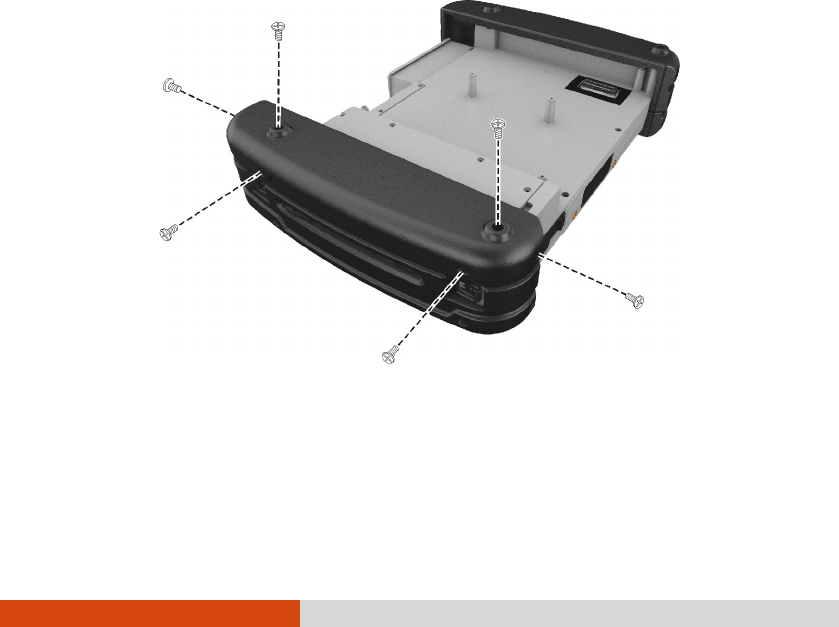
Getting Started 1-3
Installing the Battery Pack and Connecting to AC
Power
The Rugged PC operates either on the external AC power or internal battery power.
It is suggested that you use AC power when starting up the Rugged PC for the
very first time.
CAUTION: Use only the AC adapter included with your Rugged PC.
Using other AC adapters may damage the Rugged PC.
1. Make sure that the Rugged PC is turned off.
2. Place the Rugged PC upside down.
3. Remove the rubber bumper by unfastening 6 screws (as shown below) from
the bumper.

1-4 Getting Started
4. Remove the battery cover by unfastening 8 screws (as shown below) from
the cover.
5. Fit the battery pack into place (). Tighten two screws ().
6. Replace the battery cover and the rubber bumper.
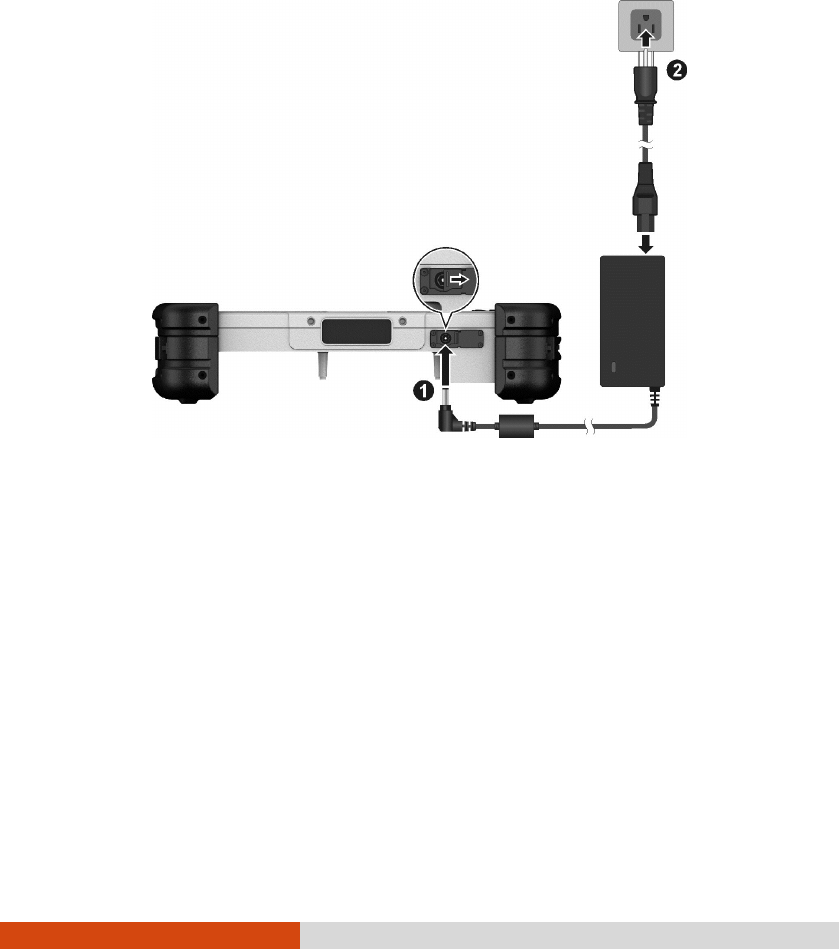
Getting Started 1-5
7. Plug the DC cord of the AC adapter to the power connector of the Rugged
PC (). Plug the female end of the AC power cord to the AC adapter and
the male end to an electrical outlet ().
8. Power is being supplied from the electrical outlet to the AC adapter and onto
your Rugged PC. Now, you are ready to turn on the Rugged PC.
CAUTION:
When you disconnect the AC adapter, disconnect from the
electrical outlet first and then from the Rugged PC. A
reverse procedure may damage the AC adapter or the Rugged
PC.
When unplugging the connector, always hold the plug head.
Never pull on the cord.
NOTE: When the AC adapter is connected, it also charges the
battery pack. For information on using battery power, see
Chapter 3.
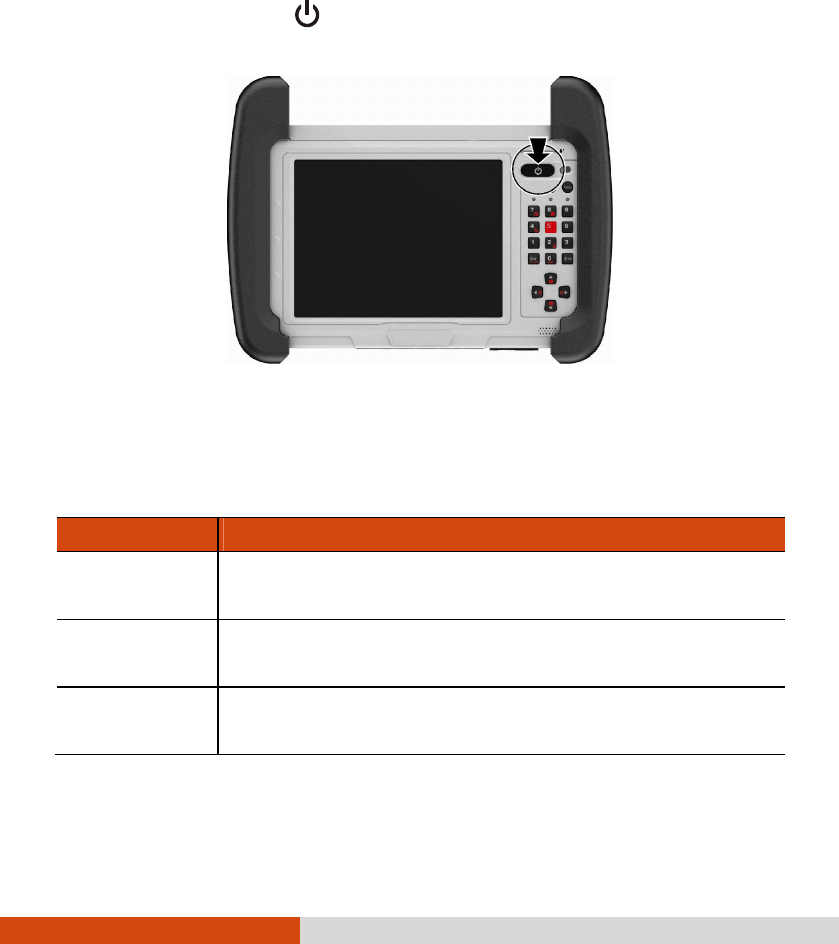
1-6 Getting Started
Turning On and Off the Rugged PC
Turning On
Press the power button ( ). The operating system such as Microsoft Windows
should start.
Turning Off
When you finish a working session, you can stop the system by turning off the
power or leaving it in Sleep or Hibernation mode:
To... Do this...
Power off
(Shutdown)
Use the Windows Start menu
in the lower left and follow the
shutdown procedure.
Sleep Press the power button* or use the Windows Start m
enu to put
the Rugged PC in Sleep mode.
Hibernate Use the Windows Start menu to put the Rugged PC in H
ibernation
mode.
* “Sleep” is the default setting of the power button. You may change what the
power button does in Windows Control Panel.

Getting Started 1-7
Press the power button to resume or turn on the system from any of these modes.
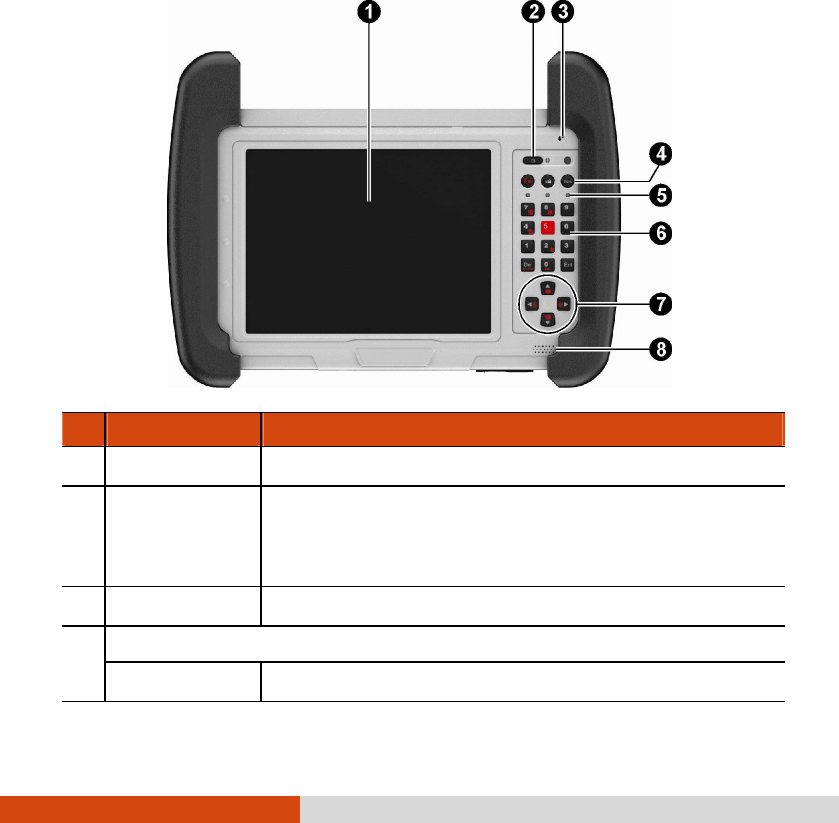
1-8 Getting Started
Taking a Look at the Rugged PC
NOTE: Depending on the model you purchased, the appearance of
your Rugged PC may not be exactly the same as those shown in
this manual.
Front Components
Ref
Component Description
Touchscreen Displays and receives information for the Rugged PC.
Power Button Turns the power ON and OFF (Sleep mode by default).
The green LED beside the button glows when
the power
is on and blinks when the system is in Sleep mode.
Microphone Receives sound and voice to record voice.
Control Buttons
Fn Toggles the Fn keylock ON and OFF.
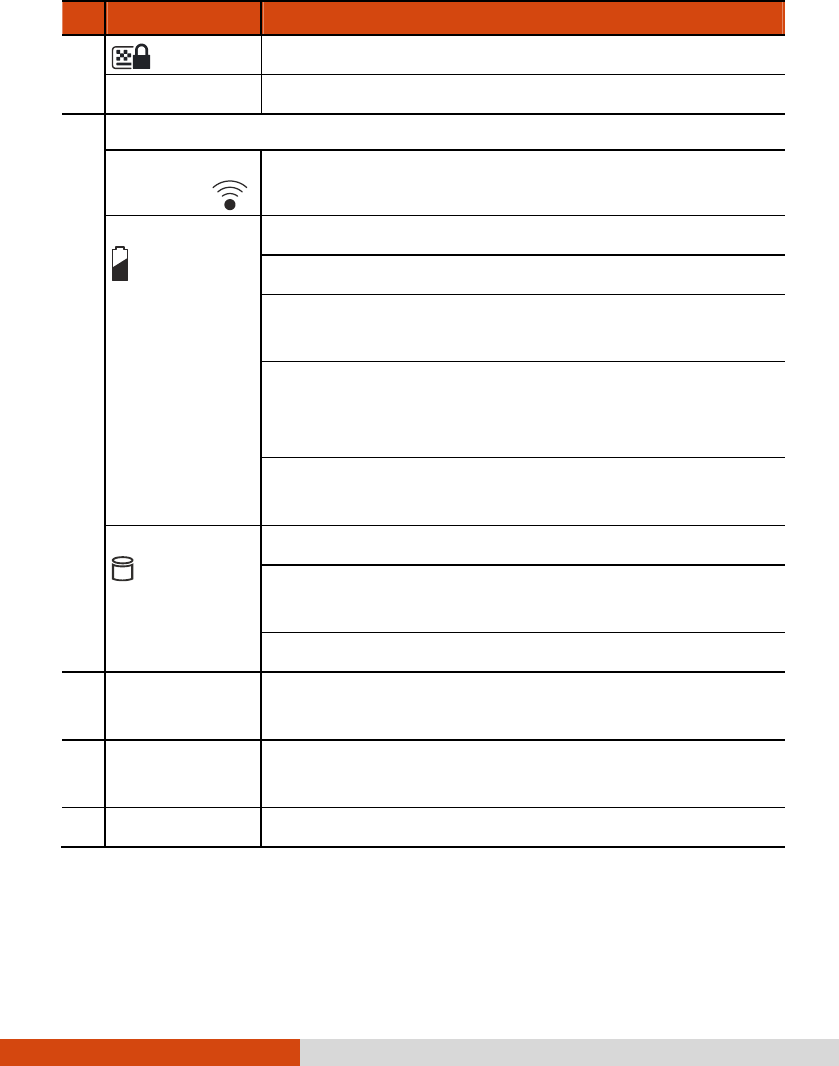
Getting Started 1-9
Ref
Component Description
Toggles the keypad lock ON and OFF.
Menu Toggles the “OSD Control Panel” ON and OFF.
Indicators
RF (Radio
Frequency)
Lights green when RF radio is on.
Battery Charge
Lights green when the battery is fully charged.
Lights amber when the battery is being charged.
Blinks red (once per second) when the battery’
s capacity
is below 10%.
Blinks red rapidly (once per 0.5 second) when there is
a thermal protection problem with the battery.
Ask for repair
service in case this happens.
Blinks amber when the battery charging is in an abnormal
state. Replace the battery in case this happens.
Hard Disk Drive
Lights green when hard disk drive is being accessed.
Lights red when the opti
onal heater is on during system
operation.
Blinks red when the optional heater is in an abnormal state.
Numeric Keypad
Provides number, Delete, and Enter keys. When Fn keylock
is on, the keys provide alternative functions.
Cursor-control
Keys
Serves as the arrow keys. When Fn keylock is on,
the keys
provide alternative functions.
Speaker Sends out sound and voice from your Rugged PC.
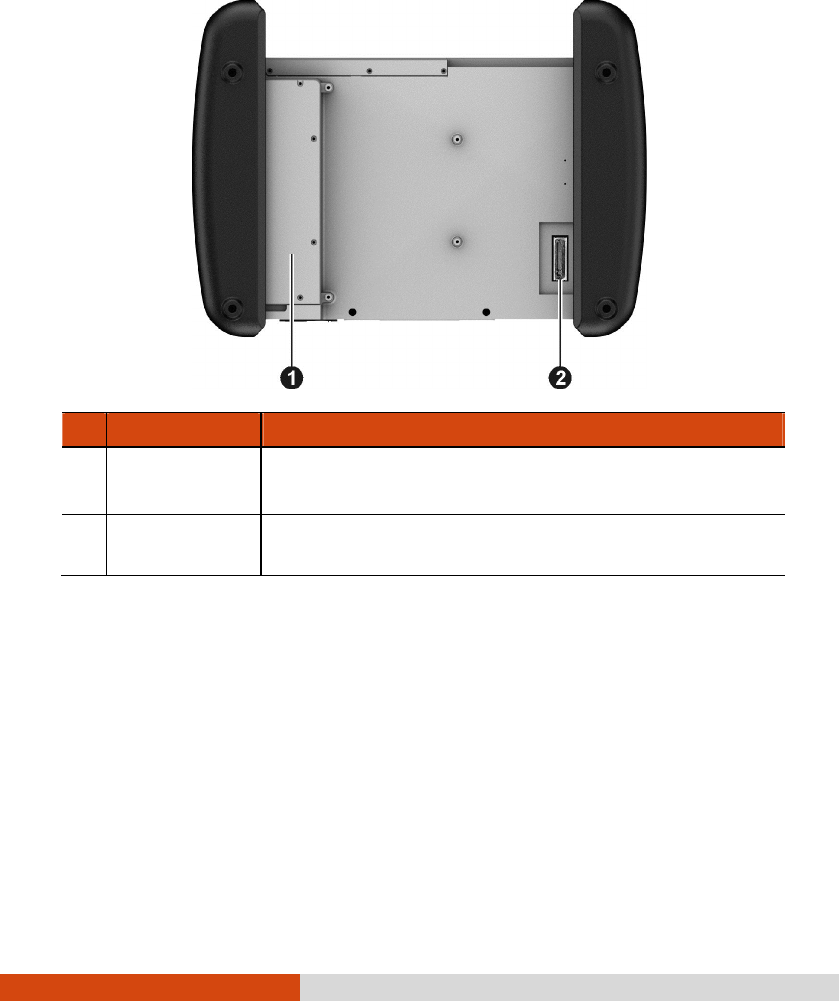
1-10 Getting Started
Rear Components
Ref
Component Description
Battery Pack Inside is the battery pack that supplies power to your Rugged
PC when external power is not connected.
Docking
Connector
Connects to the Docking Station (available as an option).
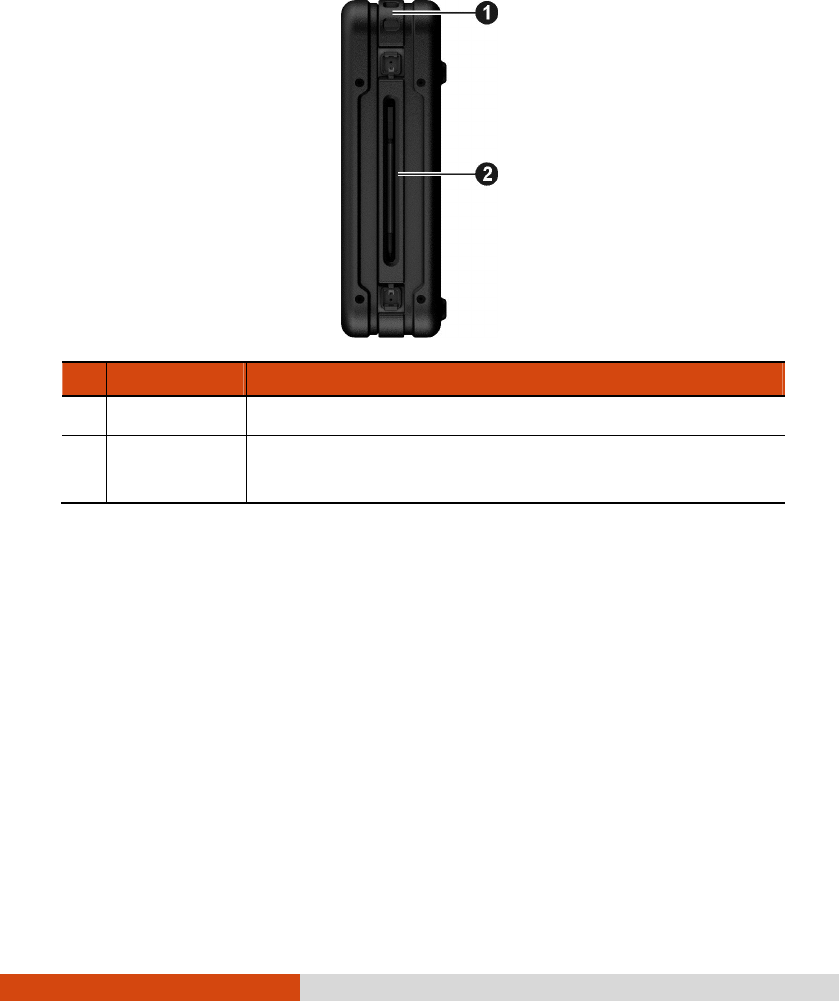
Getting Started 1-11
Right-Side Components
Ref
Component Description
Tether Hole Stylus tethered to this hole.
Stylus Serves as the input device by tapping
on the touchscreen to
make selections and enter information.
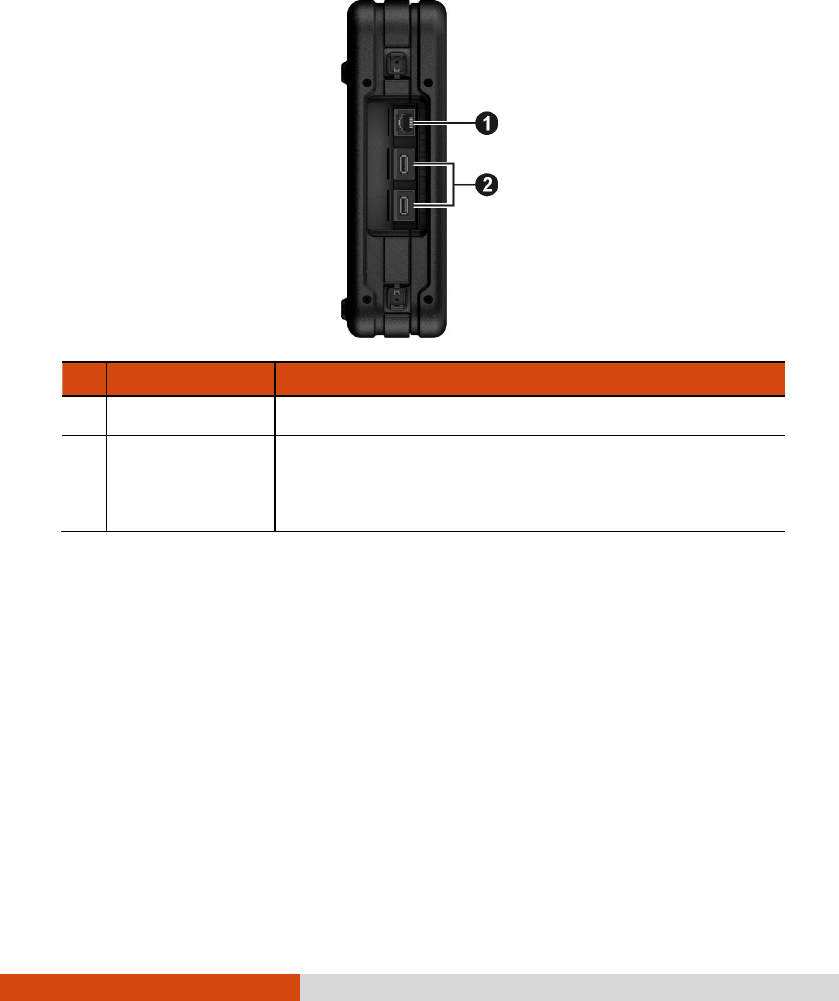
1-12 Getting Started
Left-Side Components
Ref
Component Description
RJ-45 Connector
Connects the LAN cable.
USB Ports Each of the two ports connects
a USB device, such as
a USB flash disk, printer, digital camera, joystick, and
more.
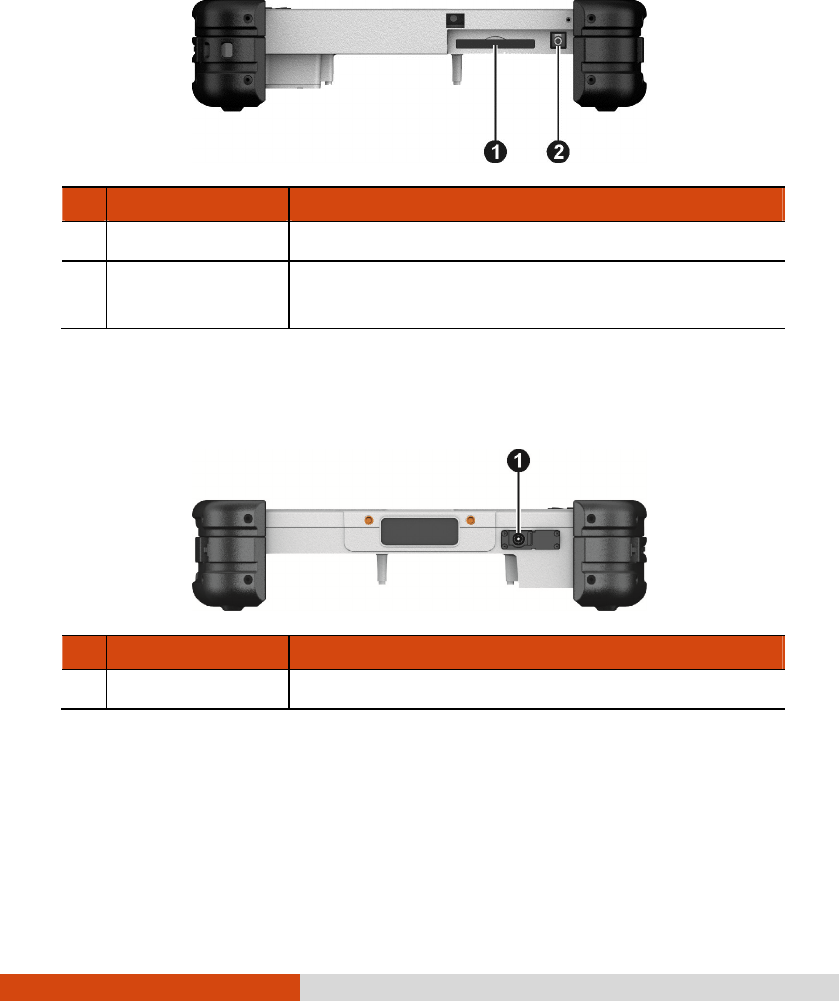
Getting Started 1-13
Top Components
Ref
Component Description
ExpressCard Slot Accepts an ExpressCard for additional functions.
Headphone Out
Connector
Connects a set of headphones or external speakers with
amplifier
Bottom Components
Ref
Component Description
Power Connector Connects the AC adapter.

Operating Your Rugged PC 2-1
Chapter 2
Operating Your Rugged
PC
This chapter provides information about the use of the Rugged PC.
If you are new to Rugged PCs, reading this chapter will help you learn the operating
basics. If you are already a computer user, you may choose to read only the parts
containing information unique to your Rugged PC.
CAUTION: The Rugged PC can get uncomfortably warm when you use
it in high temperatures. As a safety precaution in such a
circumstance, do not place the Rugged PC on your lap or touch
it with your bare hands for extended periods of time. Prolonged
body contact can cause discomfort and potentially a burn.
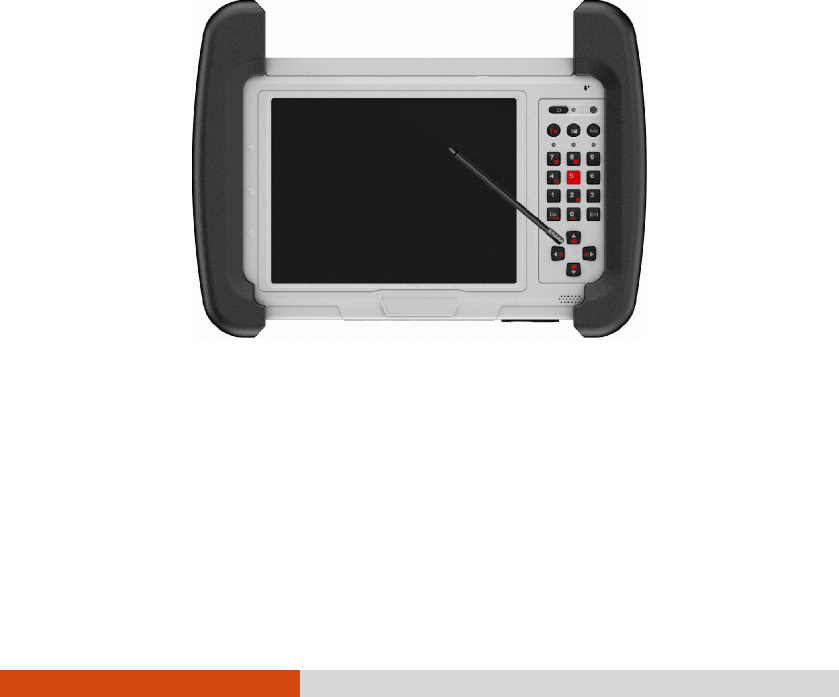
2-2 Operating Your Rugged PC
Using the Touchscreen
CAUTION: Do not use a sharp object such as a ballpoint pen or
pencil on the touchscreen. Doing so may damage the touchscreen
surface. Use your finger or the included stylus. A screen
protector film has been attached to the screen before shipment.
The film is a consumable, which will be worn out after a period
of use (6 months in average). You can purchase a new one when
replacement is required.
The screen of your Rugged PC is touch-sensitive. You can control the location
of the cursor/pointer on the screen using your finger or the included stylus to
communicate with the Rugged PC.

Operating Your Rugged PC 2-3
Here are some common terms that you should know when using the touchscreen:
Term Action
Click/Point Tap gently on the touchscreen.
Double-click Tap twice on the touchscreen rapidly.
Drag and drop Press lightly on the touchscreen and move your finger until you
reach your destination (drag). Finally, release your finger
(drop) when you finish dragging your selection to the
destination. The object will drop into the new location.
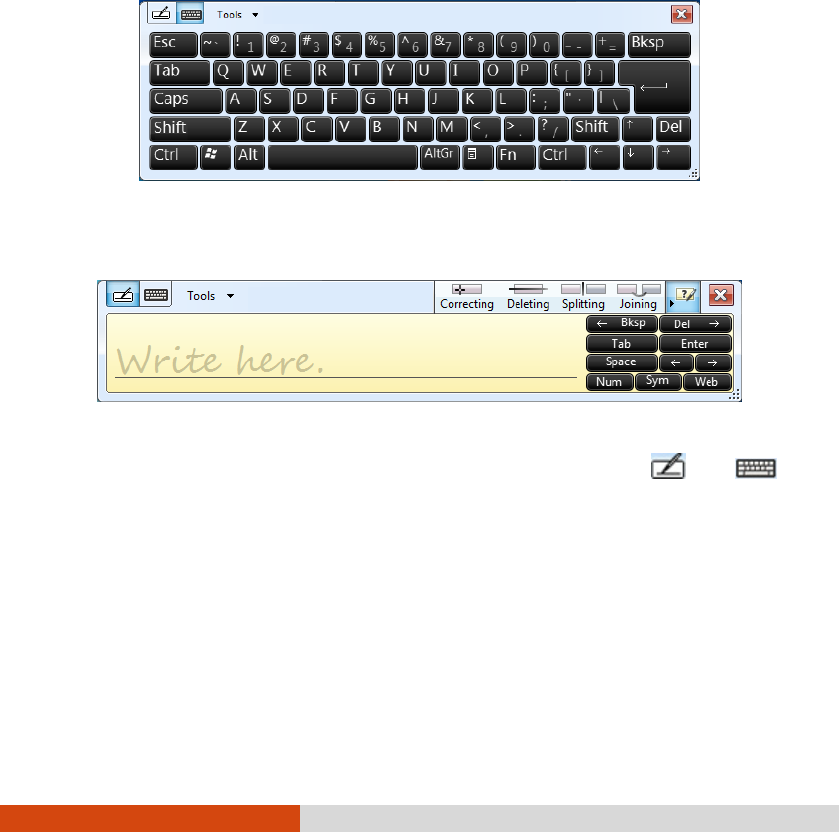
2-4 Operating Your Rugged PC
Using the Input Panel
Use the Input Panel to enter text and perform various keyboard functions. There
are two types of Input Panels for you to use in Windows 7:
Touch Keyboard allows you to enter text by tapping the keys with your stylus,
like pressing the keys on a standard keyboard.
Writing Pad allows you to write on the writing pad, like writing on a piece
of paper. Your handwriting will be converted into typed text.
To open the Input Panel, tap the Input Panel tab, which appears by default on
the left edge of the screen. To switch between the two types, tap or
at the upper left corner of the Input Panel.
NOTE: For more information on using the Input Panel, see
Windows’ online help.
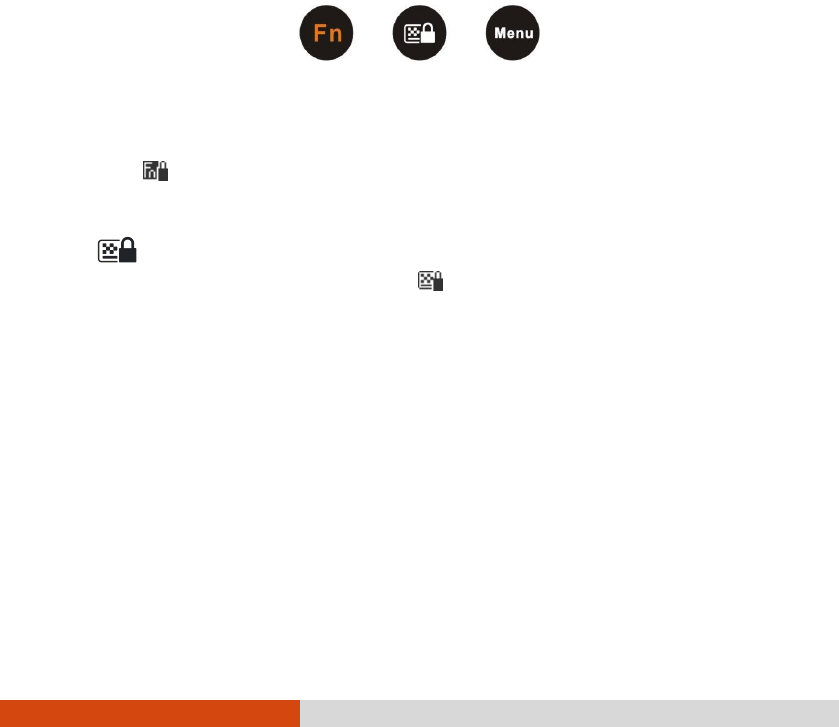
Operating Your Rugged PC 2-5
Using the Keypad
The keypad of your Rugged PC can be divided into three areas:
Control buttons
Numeric, Delete (Del), and Enter (Ent) keys
Cursor-control keys
Control Buttons
Located on top of the keypad are three control buttons:
Fn button toggles the Fn keylock ON and OFF. When ON (indicated by the
icon on the taskbar), you can use the alternative functions of the keypad
keys (as described in the next two sections).
button toggles the keypad lock ON and OFF. Press the button to lock
the keypad (indicated by the icon on the taskbar) so that accidental
pressing of the keypad does not result in unexpected operation. To unlock,
press and hold the button for more than three second.
Menu button toggles the OSD Control Panel ON and OFF.
NOTE: The status of Fn lock and keypad lock will persist through
Sleep/Hibernation mode or system power off.
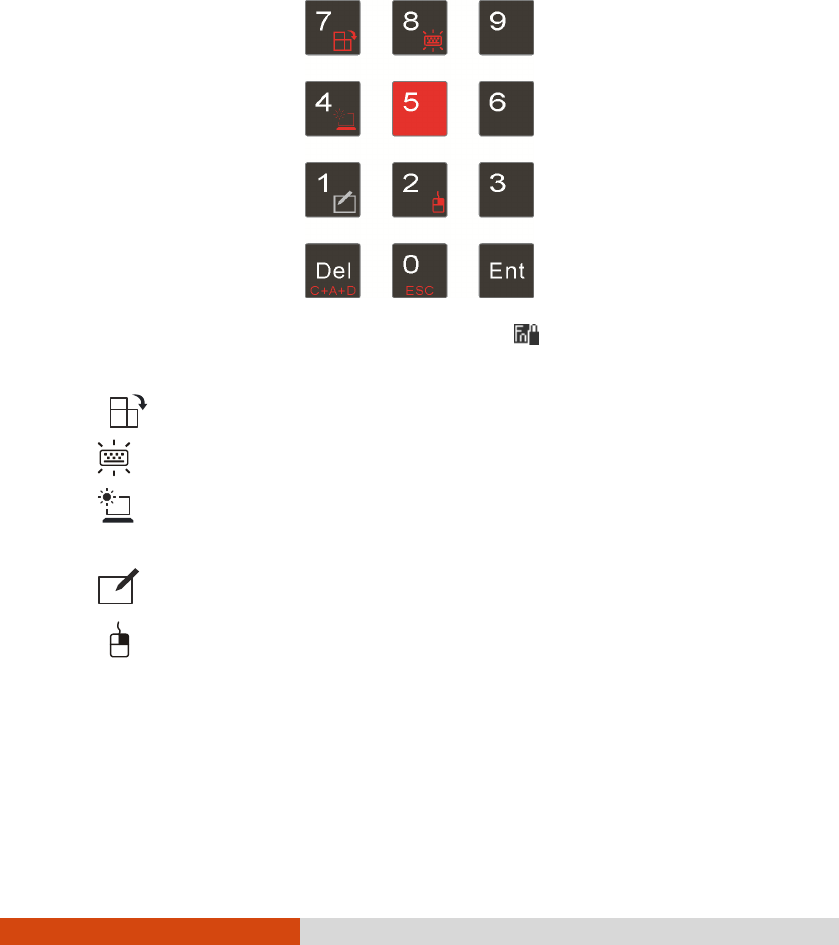
2-6 Operating Your Rugged PC
Numeric Keypad with Alternative Functions
Shown below is the 12-key numeric keypad with Delete and Enter keys.
When the Fn keylock is ON (indicated by the icon on the taskbar), the keys
with orange icons provide alternative functions as described below.
rotates the screen display by 90 with each press.
switches the keypad backlight ON and OFF.
switches the sunlight-readable mode ON and OFF. When ON, the display
brightness is set to the highest level.
switches the touchscreen OFF and ON.
serves as the mouse right-click button.
C+A+D serves as the Ctrl+Alt+Del key combination for resetting the system.
ESC serves as the Escape key.
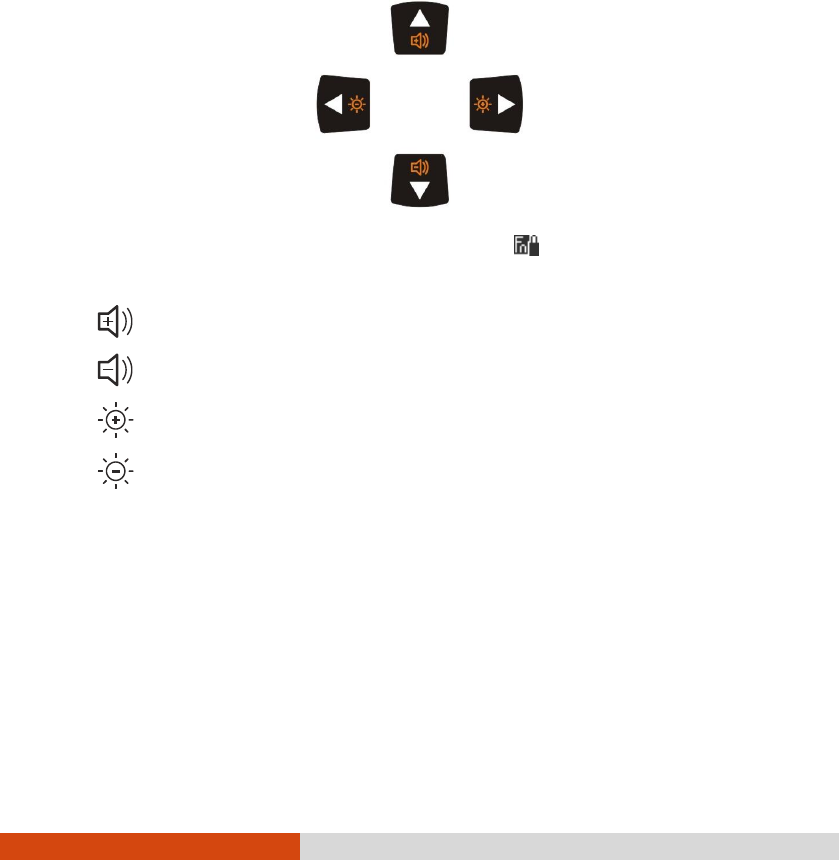
Operating Your Rugged PC 2-7
Cursor-Control Keys with Alternative Functions
Cursor-control keys control cursor movement. The word “cursor” refers to the
indicator on the screen (except for pointer on screen) that lets you know exactly
where on your screen anything you type will appear. It can take the form of a
vertical or horizontal line, a block, or one of many other shapes.
When the Fn keylock is ON (indicated by the icon on the taskbar), the keys
with orange icons provide alternative functions as described below.
increase the sound volume.
decrease the sound volume.
increase the brightness of LCD display.
decrease the brightness of LCD display.
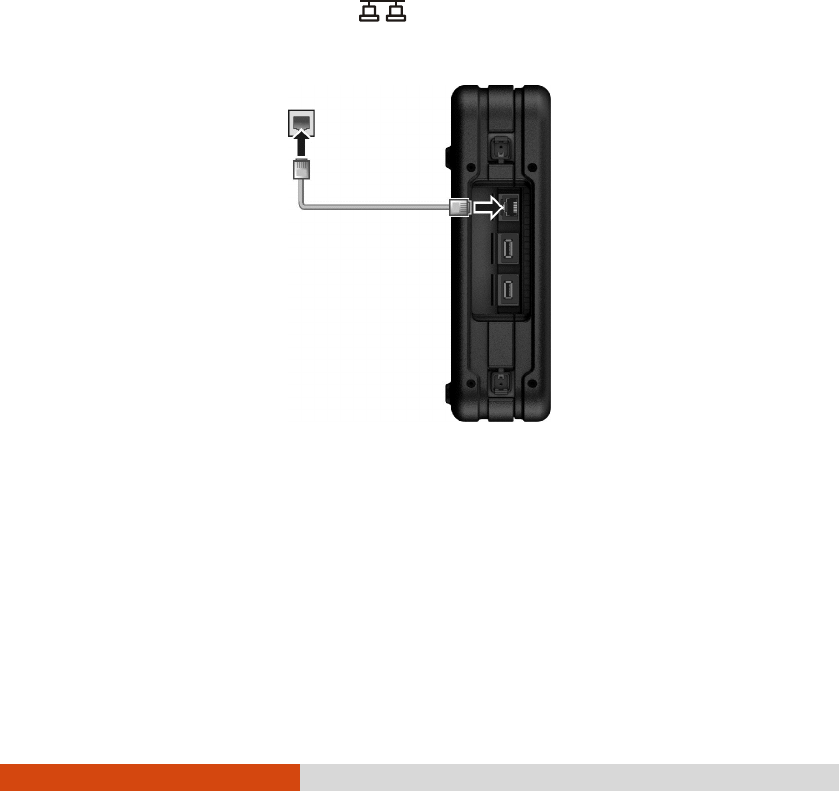
2-8 Operating Your Rugged PC
Using the Network Features
Using the LAN
The internal 10/100/1000Base-T LAN (Local Area Network) module allows you
to connect your Rugged PC to a network. It supports data transfer rate up to 1000
Mbps.
To connect the network cable to the LAN module, connect one end of the LAN
cable to the RJ-45 connector ( ) on the Rugged PC and the other end
to the network hub.

Operating Your Rugged PC 2-9
Using the Wireless LAN (Optional)
The WLAN features include:
Peer-to-Peer (Ad-Hoc) and Access Point (Infrastructure) modes support
(5GHz not support, 2.4GHz CH12 and CH13 not support.)
WEP (Wired Equivalent Privacy) 64/128-bit data encryption
The frequency range and channel support in Taiwan are as below:
frequency range: 2.4GHz portion: 2.412~2.462 GHz;
5.2GHz portion:
5.28~5.825GHz
Channel range: 2.4GHz portion: 1~11
5.2 GHz portion 56~165
IEEE 802.11a/b/g/n standard compliance
Technology 802.11a 802.11b/g 802.11n
Channel C
enter
in GHz 5.18 ~ 5.825 GHz
2.412 ~ 2.462 GHz
2.412 ~ 2.472 GHz
5.18 ~ 5.825 GHz
Channel
36, 40, 44, 48, 52,
56, 60, 64, 100,
104, 108, 112, 116,
120, 124, 128, 132,
136, 140, 149, 153,
157, 161, 165
1 ~ 13 2.4 GHz: 1 ~ 13
5.2 GHz: 36 ~ 165
Data Rates
(Mbps)
6, 9, 12, 18, 24, 36,
48, and 54 Mbps
in
OFDM mode
802.11b: 1 and 2
Mbps in DSSS mode
;
5.5
and 11 Mbps in
CCK mode
130 Mbps under the
condition of 2 spatial
streams, 64-QAM
modulation type, 20
MHz-
wide channel, and
5/6 coding rate.
802.11g: 6, 9, 12,
18, 24, 36, 48, and
54 Mbps in OFDM
mode
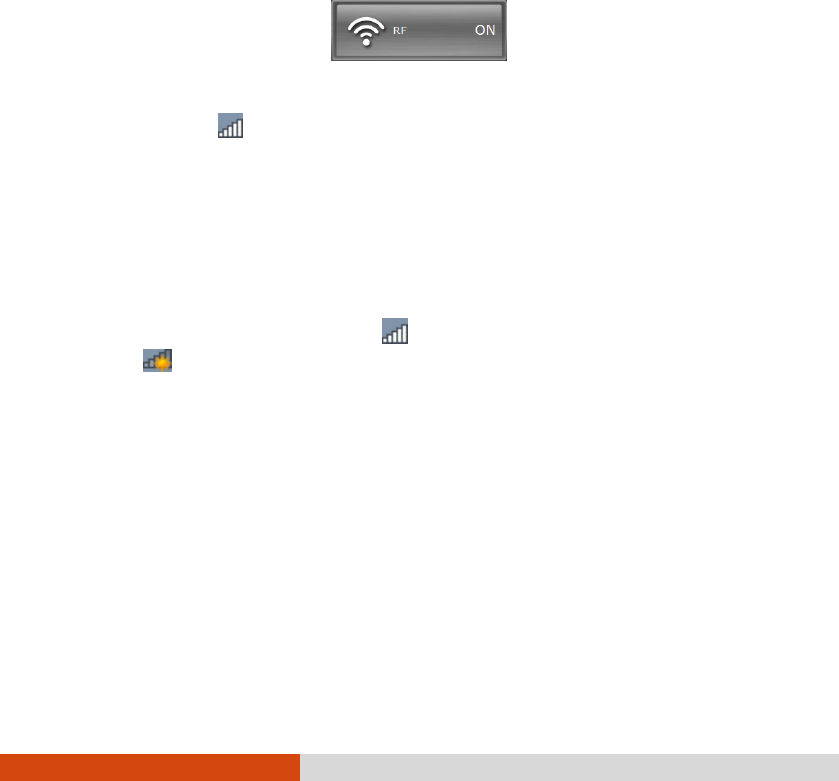
2-10 Operating Your Rugged PC
Turning On/Off the WLAN Radio
NOTE: The FAA (Federal Aviation Agency) has deemed it unsafe
to operate wireless devices in aircraft as this may interfere
with flight safety. Turn off wireless LAN when using your Rugged
PC in the airplane.
1. Press the Menu button on your Rugged PC to open the OSD Control Panel.
2. Click the RF button to switch the wireless radio on/off. The word ON or OFF
on the button indicates the current status.
3. Windows Mobility Center has wireless network turned on by default. The Wireless
Network icon on the taskbar should appear without a red X. (In case you
have previously turned it off in Windows Mobility Center, be sure to turn it
on when using the function the next time.)
Connecting to a Wireless Network
1. Make sure that the WLAN function is enabled (as described above).
2. Tap the Wireless Network icon on the taskbar. (An orange light in the
icon indicates connections are available.)
3. In the list of available wireless networks, select a network, and then click
Connect.
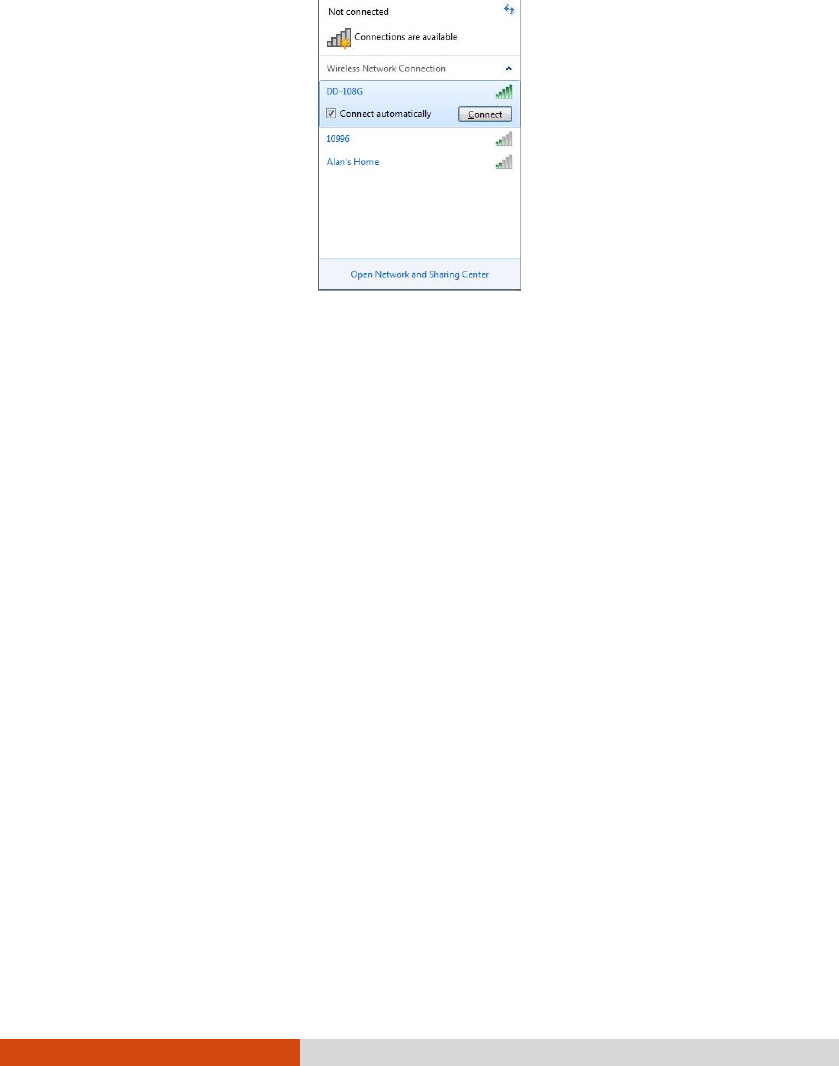
Operating Your Rugged PC 2-11
4. Some networks require a network security key or passphrase. To connect to
one of those networks, ask your network administrator or Internet service provider
(ISP) for the security key or passphrase.
For more information on setting a wireless network connection, refer to Windows
online help.
NOTE: You can use Intel® PROSet Wireless to take full advantage
of the WiFi capabilities of your Rugged PC. See the Help of
the utility for instructions.
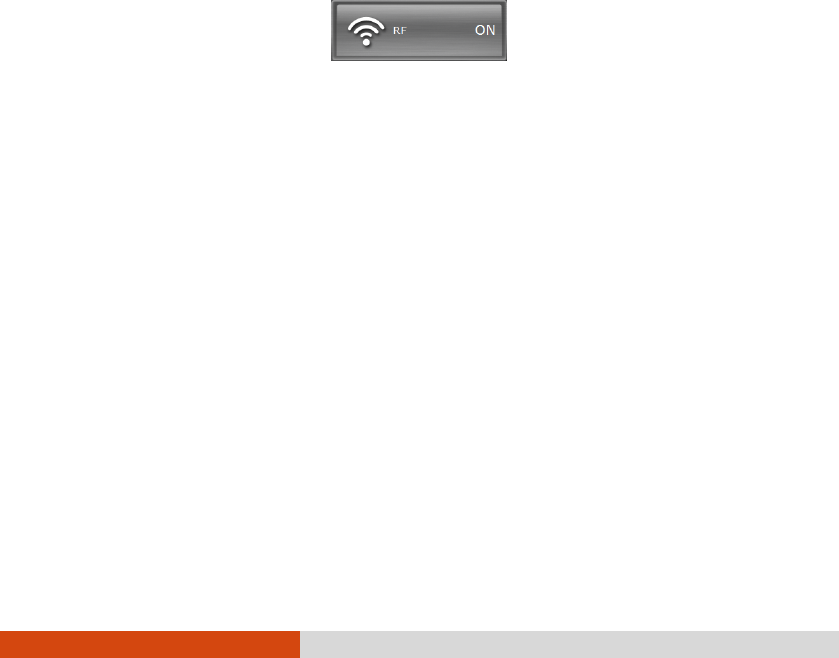
2-12 Operating Your Rugged PC
Using the BT Feature (Optional)
The BT 4.0+EDR technology allows short-range (about 50 meters) wireless
communications between devices without requiring a cable connection. Data can be
transmitted through walls, pockets and briefcases as long as two devices are within
range.
Turning On/Off the BT Radio
1. Press the Menu button on your Rugged PC to open the OSD Control Panel.
2. Click the RF button to switch the wireless radio on/off. The word ON or OFF
on the button indicates the current status.

Managing Power 3-1
Chapter 3
Managing Power
Your Rugged PC operates either on external AC power or on internal battery power.
This chapter tells you how you can effectively manage power. To maintain optimal
battery performance, it is important that you use the battery in the proper way.
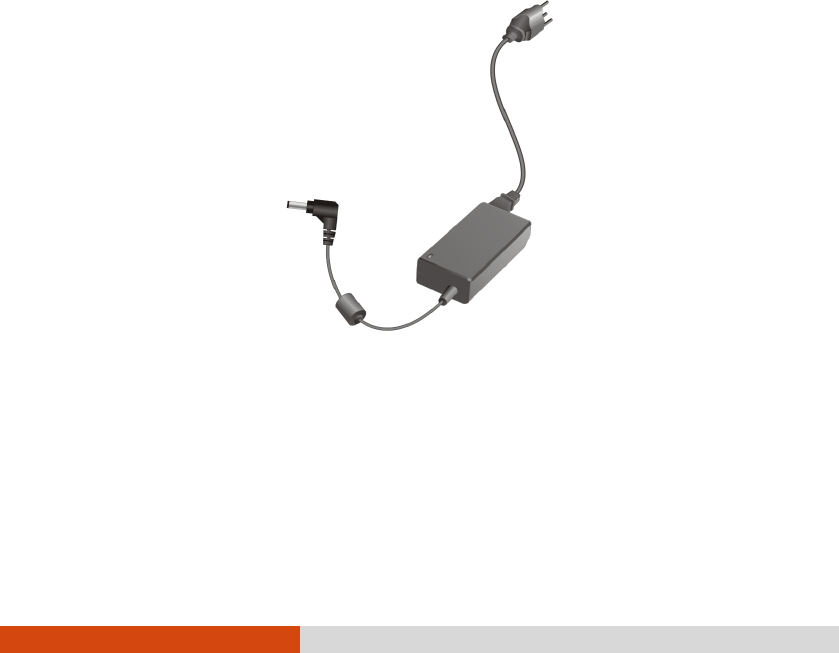
3-2 Managing Power
AC Adapter
CAUTION:
The AC adapter is designed for use with your Rugged PC only.
Connecting the AC adapter to another device can damage the
adapter.
The AC power cord supplied with your Rugged PC is for use
in the country where you purchased your Rugged PC. If you
plan to go overseas with the Rugged PC, consult your dealer
for the appropriate power cord.
When you disconnect the AC adapter, disconnect from the
electrical outlet first and then from the Rugged PC. A
reverse procedure may damage the AC adapter or Rugged PC.
When unplugging the connector, always hold the plug head.
Never pull on the cord.
The AC adapter serves as a converter from AC (Alternating Current) to DC (Direct
Current) power because your Rugged PC runs on DC power, but an electrical
outlet usually provides AC power. It also charges the battery pack when connected
to AC power.
The adapter operates on any voltage in the range of 100~240 V AC.

Managing Power 3-3
Battery Pack
The battery pack is the internal power source for the Rugged PC. It is rechargeable
using the AC adapter.
The operating time of a fully charged battery pack depends on how you are using
the Rugged PC. When your applications often access peripherals, you will experience
a shorter operating time.
Charging the Battery Pack
NOTE:
Charging will not start if the battery’s temperature is below
0 C (32 F) or above 40 C (104 F); the charging process will
stop if the battery’s temperature gets above 60 C (140 F).
To avoid damaging the battery under this situation,
disconnect the AC adapter and wait for the battery to return
to room temperature before charging again.
During charging, do not disconnect the AC adapter before the
battery has been fully charged; otherwise you will get a
prematurely charged battery.
To charge the battery pack, connect the AC adapter to the Rugged PC and an
electrical outlet. The Battery Charge Indicator ( ) on the Rugged PC glows
amber to indicate that charging is in progress. You are advised to keep the Rugged
PC power off while the battery is being charged. When the battery is fully charged,
the Battery Charge Indicator glows green.
It takes approximately 2 hours to fully charge the Li-Ion battery pack at a room
temperature of 25 C (77 F) (may need a longer charging time at lower
temperatures).
CAUTION: After the Rugged PC has been fully recharged, do not
immediately disconnect and reconnect the AC adapter to charge
it again. Doing so may damage the battery.
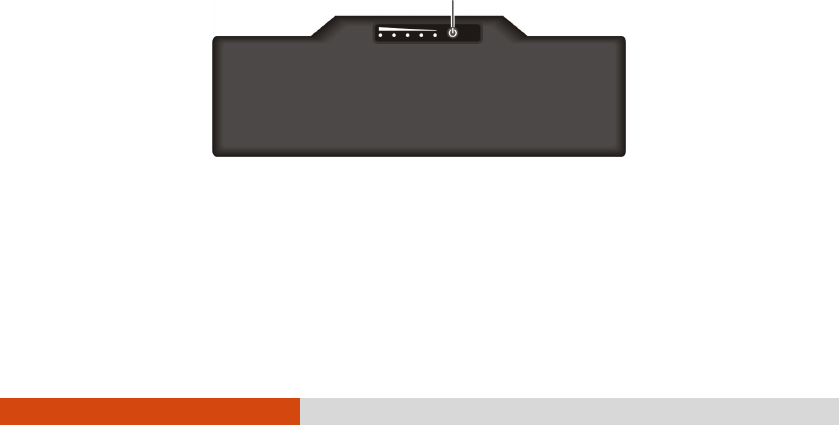
3-4 Managing Power
NOTE: The battery level may automatically lessen due to the
self-discharge process (0.21% per day), even when the battery
pack is fully charged (100%). This happens no matter if the
battery pack is installed in the Rugged PC.
Checking the Battery Level
NOTE: Any battery level indication is an estimated result. The
actual operating time can be different from the estimated time,
depending on how you are using the Rugged PC.
By Operating System
You can check the approximate battery level using the battery meter function of
the operating system. To read the battery level in Windows, click the battery icon
on the taskbar.
By Gas Gauge
On the exterior side of the battery pack is a gas gauge for displaying the estimated
battery charge. When the battery pack is not installed in the Rugged PC and you
want to know the battery charge, you can press the switch with a pointed device
to see the corresponding value of indicator segment that light green.
The value of the corresponding green segment indicates the relative percentage of
the battery charge. The battery pack is fully discharged when you see no segment
glowing green.
Switch
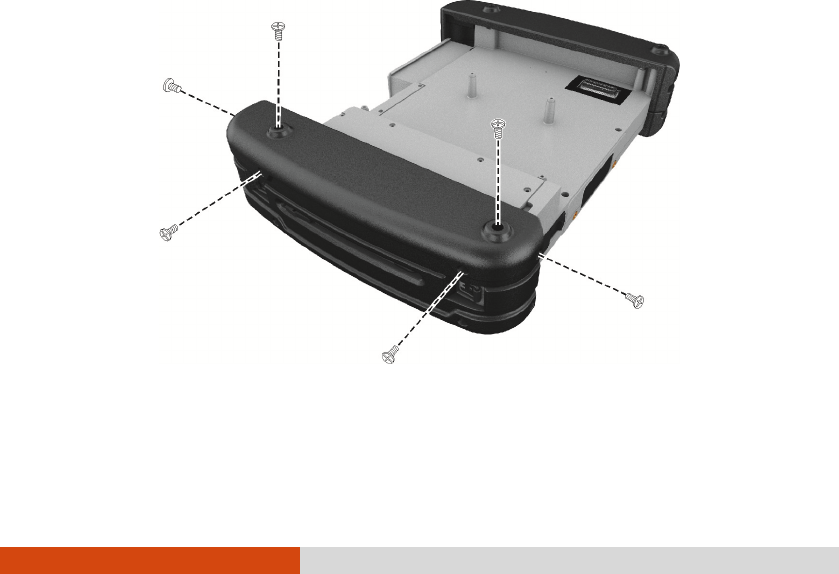
Managing Power 3-5
Replacing the Battery Pack
CAUTION:
There is danger of explosion if the battery is incorrectly
replaced. Replace the battery only with the Rugged PC
manufacturer’s battery packs. Discard used batteries
according to the dealer’s instructions.
Do not attempt to disassemble the battery pack.
If you often rely on battery power for a long period of time while traveling, you
may consider the purchase of an additional battery pack from your dealer and keep
it with you in a fully charged state as a backup.
To replace the battery pack, follow these steps:
1. Make sure that the Rugged PC is not turned on or connected to AC power.
2. Remove the rubber bumper by unfastening 6 screws (as shown below) from
the bumper.
3. Remove the battery cover by unfastening 8 screws (as shown below) from
the cover.
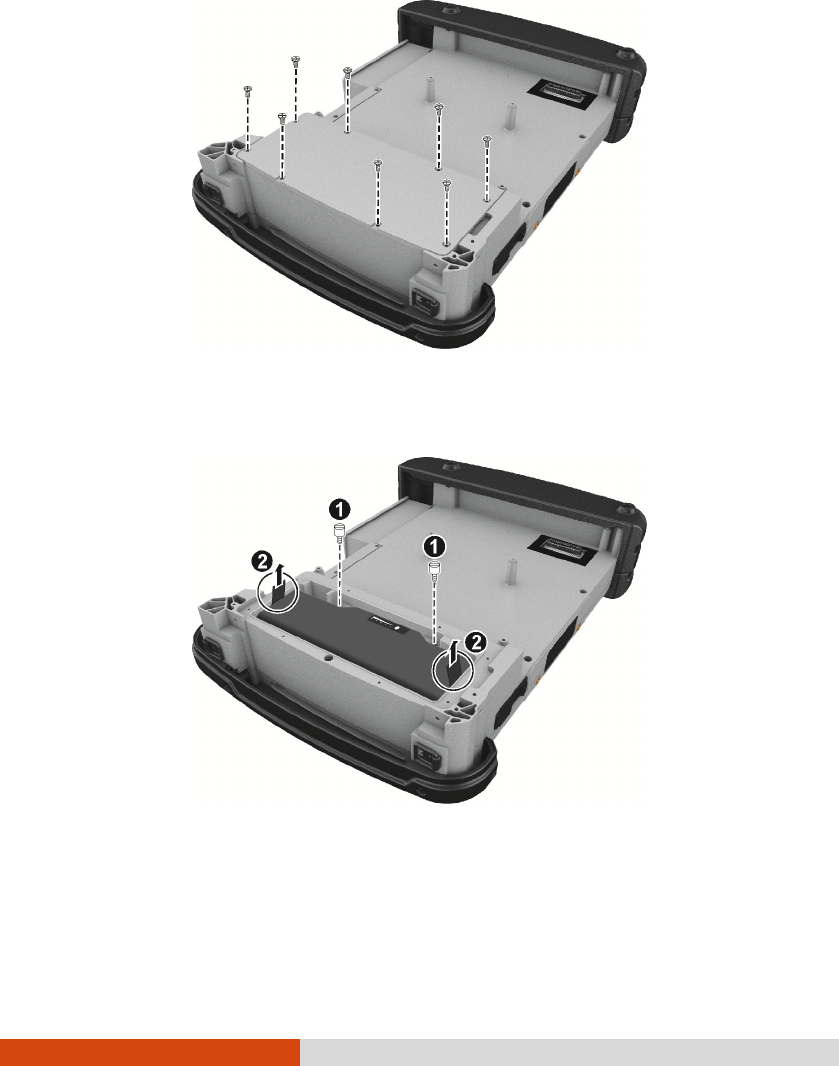
3-6 Managing Power
4. Remove the two screws (). Pull the ribbon strips to lift the battery pack
out of the computer ().
5. Fit another battery pack into place. Tighten two screws.
6. Replace the battery cover and the rubber bumper.

Managing Power 3-7
Battery Low Signals and Actions
When the battery is low, Windows gives warning messages and the Battery Charge
Indicator ( ) blinks red to alert you.
NOTE: You can set up your threshold and signals of Battery Low
under Windows.
Immediately save your data upon Battery Low. The remaining operating time depends
on how you are using the Rugged PC.
Always respond to Battery Low by placing your Rugged PC on the Sleep or
Hibernation mode, turning off the Rugged PC, or connecting the AC adapter. If
you do not take any action, the Rugged PC will automatically hibernate and turn
off.
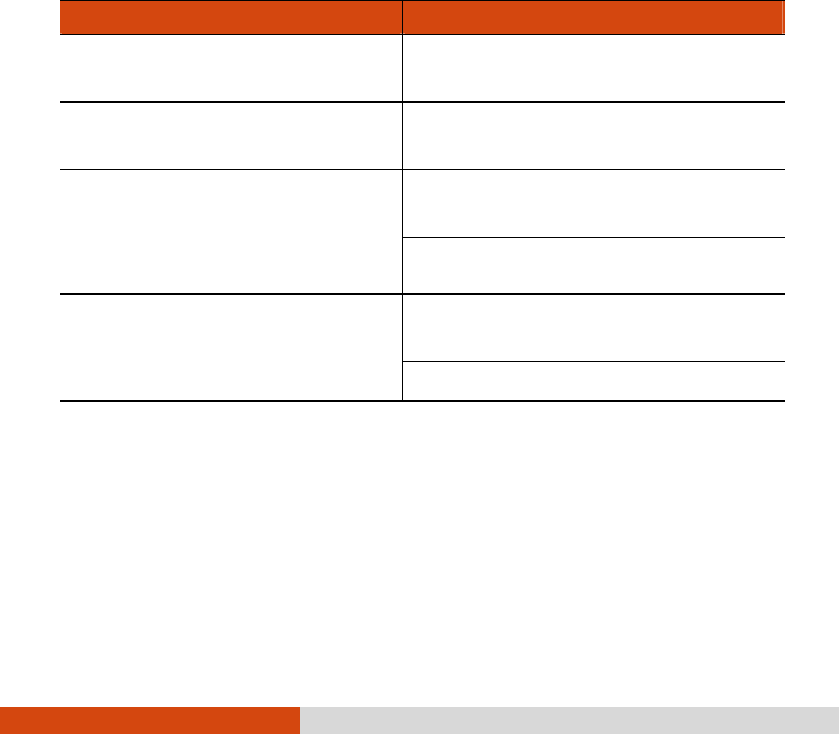
3-8 Managing Power
Power Management
Your Rugged PC supports ACPI (Advanced Configuration and Power Interface) for
power management. The power management feature allows you to reduce the power
consumption for energy saving.
With an ACPI-compliant operating system such as Windows, power supply to different
Rugged PC components is controlled on an as-needed basis. This allows maximum
power conservation and performance at the same time.
In general, Windows’ power management works in this way:
What... When...
Power to the hard disk is turned off
When the hard disk has been idle for a set
period.
Power to the display is turned off
When the display has been idle for a set
period.
The Rugged PC enters the Sleep
mode. The hard disk and display are
turned off and the entire system
consumes less power.
When the entire system has been idle for
a set period.
When you manually activate the mode.
The Rugged PC enters the Hibernation
mode. (See the next subsection for
more information.)
When the entire system has been idle for
a set period.
When you manually activate the mode.
For detailed information on power management, see Windows’ Help.

Managing Power 3-9
Hibernation
Hibernation is a very useful feature. People frequently open many applications when
they use computers. It takes some time to get all these applications open and running,
and normally they all have to be closed before the computer can be turned off.
When you use the hibernation feature, you do not have to close the applications.
The Rugged PC stores the state of your Rugged PC to a file on the hard disk
and then shuts down. The next time you turn on your Rugged PC, you return to
exactly where you left off.

3-10 Managing Power
Power-Saving Tips
Aside from enabling your Rugged PC’s power saving mode (see previous section),
you can do your part to maximize the battery’s operating time by following these
suggestions.
Do not disable Power Management.
Decrease the LCD brightness to the lowest comfortable level.
Shorten the length of time before Windows turn off the display.
Many USB devices use power just by being connected. If you use a USB mouse,
you can save power by disconnecting the mouse and using the optional stylus.
If you use a USB flash drive, unplug it when you are not using it.
Remove the ExpressCard (if inserted) when not using it.
Turn off the wireless radio if you are not using the wireless module.
Turn off the Rugged PC when you are not using it.
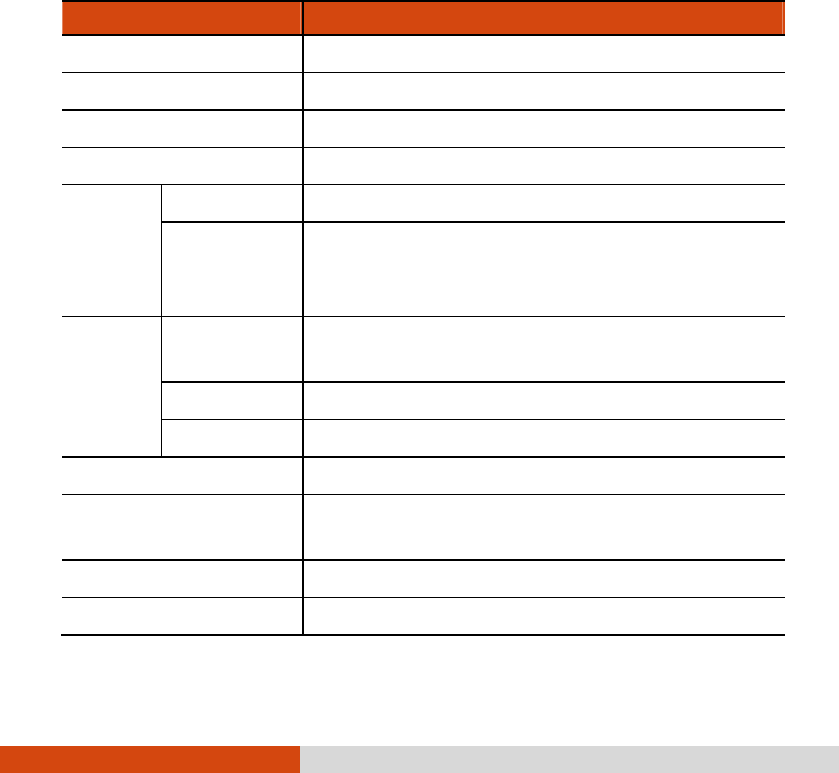
Specifications A-1
Appendix A
Specifications
NOTE: Specifications are subject to change without any prior
notice.
Parts Specifications
CPU Intel® Cedar Trail N2600 1.60 GHz
Chipset Intel® Tiger Point NM10 Express
BIOS Phoenix, 2MB Flash EEPROM
RAM 2GB DDR3-1066 SO-DIMM
Video Controller Intel® GMA 3650 (Integrated in Cedar Trial)
Display Panel
8.4-inch SVGA 800x600 LCD, sunlight readable,
500 Nits maximum brightness, resistive touch
screen,
non-glare type with AR/AG film
Audio Features High Definition audio, volume control via
keypad and
software
Speaker Integrated speaker
Microphone Integrated microphone
Hard disk drive mSATA, 32GB SSD(Solid State Drive)
I/O ports USB (2.0) × 2, RJ-45, headphone out,
ExpressCard/54, Docking
LAN 10/100/1000 Mbps Ethernet
Wireless LAN (option) 802.11 a/b/g/n
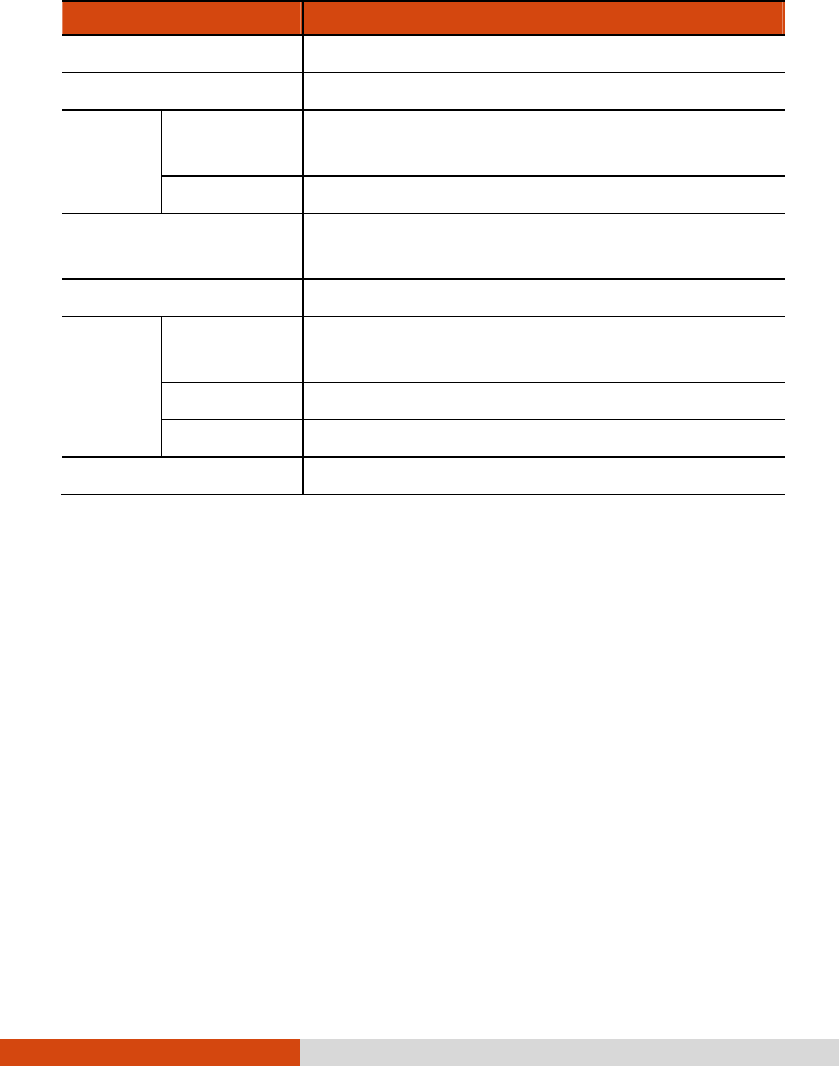
A-2 Specifications
Parts Specifications
BT BT 4.0/2.1+EDR
Security TPM 1.2
Power AC adapter Universal 90 W; input: 100240 V
, 50/60 Hz; output:
19V
Battery Lithium-ion cylindrical battery, 8 cells, 2100mAh
Dimension (LxW×D) 280×184×50mm (11×7.2×1.97 inch) (not including
rubber bumper and test box)
Weight 2.8 kg (6.17 lb)
Environ-
ment
Temperature Operating: –20 C (–4 F) to 40 C (104 F)
Storage: –40 C (–40 F) to 71 C (160 F)
Humidity Relative: 0 % to 95 % non-condensing
Compliance MIL-STD-810G and IP65
Regulations CE, FCC, UL

Regulatory Information B-1
Appendix B
Regulatory Information
This appendix provides regulatory statements and safety notices on your Rugged
PC.
NOTE: Marking labels located on the exterior of your Rugged PC
indicate the regulations that your model complies with. Please
check the marking labels and refer to the corresponding
statements in this appendix. Some notices apply to specific
models only.

B-2 Regulatory Information
USA – FCC
Class B
Federal Communications Commission Radio Frequency Interference Statement
This device complies with Part 15 of the FCC Rules. Operation is subject to the
following two conditions: (1) this device may not cause harmful interference, and
(2) this device must accept any interference received, including interference that
may cause undesired operation.
NOTE:
This equipment has been tested and found to comply with the limits for a Class
B digital device pursuant to Part 15 of the FCC Rules. These limits are designed
to provide reasonable protection against harmful interference in a residential
installation. This equipment generates, uses, and can radiate radio frequency energy
and, if not installed and used in accordance with the instructions, may cause harmful
interference to radio communications. However, there is no guarantee that interference
will not occur in a particular installation. If this equipment does cause harmful
interference to radio or television reception, which can be determined by turning
the equipment off and on, the user is encouraged to try to correct the interference
by one or more of the following measures:
Reorient or relocate the receiving antenna.
Increase the separation between the equipment and receiver.
Connect the equipment into an outlet on a circuit different from that to which
the receiver is connected.
Consult the dealer or an experienced radio/TV technician for help.
Any changes or modifications not expressly approved by the manufacturer could
void the user’s authority to operate the equipment.
Please note:

Regulatory Information B-3
This transmitter must not be co-located or operating in conjunction with any other
antenna or transmitter.
The use of a non-shielded interface cable with this equipment is prohibited.
Notes
The country code selection is for non-US models only and is not available to all
US models. Per FCC regulation, all WiFi products marketed in US must be fixed
to US operation channels only.
RF Exposure Information (SAR)
This device meets the government’s requirements for exposure to radio waves.
This device is designed and manufactured not to exceed the emission limits for
exposure to radio frequency (RF) energy set by the Federal Communications
Commission of the U.S. Government.
The exposure standard for wireless device employs a unit of measurement known
as the Specific Absorption Rate, or SAR. The SAR limit set by the FCC is 1.6W/kg.
Tests for SAR are conducted using standard operating positions accepted by the
FCC with the device transmitting at its highest certified power level in all tested
frequency bands. Although the SAR is determined at the highest certified power
level, the actual SAR level of the device while operating can be well below the
maximum value. This is because the device is designed to operate at multiple power
levels so as to use only the poser required to reach the network. In general, the
closer you are to a wireless base station antenna, the lower the power output.
While there may be differences between the SAR levels of various devices and
at various positions, they all meet the government requirement.
The FCC has granted an Equipment Authorization for this device with all reported
SAR levels evaluated as in compliance with the FCC RF exposure guidelines. SAR

B-4 Regulatory Information
information on this device is on file with the FCC and can be found under the
Display Grant section of www.fcc.gov/oet/ea/fccid after searching on FCC ID:
QYLE100AVL2.

Regulatory Information B-5
Canada – IC
Class B
Canadian Department of Communications
Radio Interference Regulations Class B Compliance Notice
This Class B digital apparatus complies with Canadian ICES-003.Cet appareil
numérique de la classe B est conforme à la norme NMB-003 du Canada.This
digital apparatus does not exceed the Class B limits for radio noise emissions from
digital apparatus set out in the Radio Interference Regulations of the Canadian
Department of Communications.
Le présent appareil numérique n’émet pas de bruits radioélectriques dépassant les
limites applicables aux appareils numériques de la classe B prescrites dans le
Règlement sur le brouillage radioélectrique édicté par le ministère des
Communications du Canada.
This device complies with Industry Canada license-exempt RSS
standard(s).Operation is subject to the following two conditions: (1) This device
may not cause harmful interference, and (2) this device must accept any interference
received, including interference that may cause undesired operation.
Le présent appareil est conforme aux CNR d'Industrie Canada applicables aux
appareils radio exempts de licence. Son fonctionnement est sujet aux deux conditions
suivantes: (1) le dispositif ne doit pas produire de brouillage préjudiciable, et (2)
ce dispositif doit accepter tout brouillage reçu, y compris un brouillage susceptible
de provoquer un fonctionnement indésirable.
Caution:
(i) the device for operation in the band 5150-5250 MHz is only for indoor use
to reduce the potential for harmful interference to co-channel mobile satellite systems;

B-6 Regulatory Information
(ii) the maximum antenna gain permitted for devices in the bands 5250-5350
MHz and 5470-5725 MHz shall comply with the e.i.r.p. limit; and
(iii) the maximum antenna gain permitted for devices in the band 5725-5825
MHz shall comply with the e.i.r.p. limits specified for point-to-point and non
point-to-point operation as appropriate.
(iv) Users should also be advised that high-power radars are allocated as primary
users (i.e. priority users) of the bands 5250-5350 MHz and 5650-5850 MHz
and that these radars could cause interference and/or damage to LE-LAN devices.
(v) This device and its antenna(s) must not be co-located or operating in
conjunction with any other antenna or transmitter, except tested built-in radios. The
County Code Selection feature is disabled for products marketed in the US/ Canada.
Avertissement :
Le guide d’utilisation des dispositifs pour réseaux locaux doit inclure des instructions
précises sur les restrictions susmentionnées, notamment :
(i) les dispositifs fonctionnant dans la bande 5 150-5 250 MHz sont réservés
uniquement pour une utilisation à l’intérieur afin de réduire les risques de brouillage
préjudiciable aux systèmes de satellites mobiles utilisant les mêmes canaux;
(ii) le gain maximal d’antenne permis pour les dispositifs utilisant les bandes 5
250-5 350 MHz et 5 470-5 725 MHz doit se conformer à la limite de p.i.r.e.;
(iii) le gain maximal d’antenne permis (pour les dispositifs utilisant la bande 5
725-5 825 MHz) doit se conformer à la limite de p.i.r.e. spécifiée pour l’exploitation
point à point et non point à point, selon le cas.
(iv) De plus, les utilisateurs devraient aussi être avisés que les utilisateurs de
radars de haute puissance sont désignés utilisateurs principaux (c.-à-d., qu’ils
ont la priorité) pour les bandes 5 250-5 350 MHz et 5 650-5 850 MHz et
que ces radars pourraient causer du brouillage et/ou des dommages aux dispositifs
LAN-EL.

Regulatory Information B-7
(v) Cet appareil et son antenne ne doivent pas être situés ou fonctionner en
conjonction avec une autre antenne ou un autre émetteur, exception faites des radios
intégrées qui ont été testées. La fonction de sélection de l'indicatif du pays est
désactivée pour les produits commercialisés aux États-Unis et au Canada.
Radiation Exposure Statement:
The product comply with the Canada portable RF exposure limit set forth for an
uncontrolled environment and are safe for intended operation as described in this
manual. The further RF exposure reduction can be achieved if the product can be
kept as far as possible from the user body or set the device to lower output power
if such function is available.
Déclaration d'exposition aux radiations :
Le produit est conforme aux limites d'exposition pour les appareils portables RF
pour les Etats-Unis et le Canada établies pour un environnement non contrôlé.
Le produit est sûr pour un fonctionnement tel que décrit dans ce manuel. La réduction
aux expositions RF peut être augmentée si l'appareil peut être conservé aussi loin
que possible du corps de l'utilisateur ou que le dispositif est réglé sur la puissance
de sortie la plus faible si une telle fonction est disponible.

B-8 Regulatory Information
Europe – EU Declaration of Conformity
This device complies with the essential requirements of the R&TTE Directive
1999/5/EC. The following test methods have been applied in order to prove
presumption of conformity with the essential requirements of the R&TTE Directive
1999/5/EC:
EN 60950-1: 2006+A11:2009:+A1:2010+A12:2011+A2:2013
Safety of Information Technology Equipment
EN50332-2:2003
Sound system equipment - Headphones and earphones associated with portable
audio equipment – Maximum sound pressure level measurement methodology and
limit considerations - Part 2: Matching of sets with headphones if either or both
are offered separately
EN50566: 2013
Product standard to demonstrate compliance of radio frequency fields from handheld
and body-mounted wireless communication devices used by the general public (30
MHz – 6 GHz)
EN 62209-2:2010
EN62479:2010
EN 301 489-1 V1.9.2: 2011
Electromagnetic compatibility and Radio Spectrum Matters (ERM); ElectroMagnetic
Compatibility (EMC) standard for radio equipment and services; Part 1: Common
technical requirements
EN 301 489-17 V2.21 2012
Electromagnetic compatibility and Radio spectrum Matters (ERM); ElectroMagnetic
Compatibility (EMC) standard for radio equipment and services; Part 17: Specific
conditions for 2,4 GHz wideband transmission systems and 5 GHz high performance
RLAN equipment
.
V2.2.1: 2012
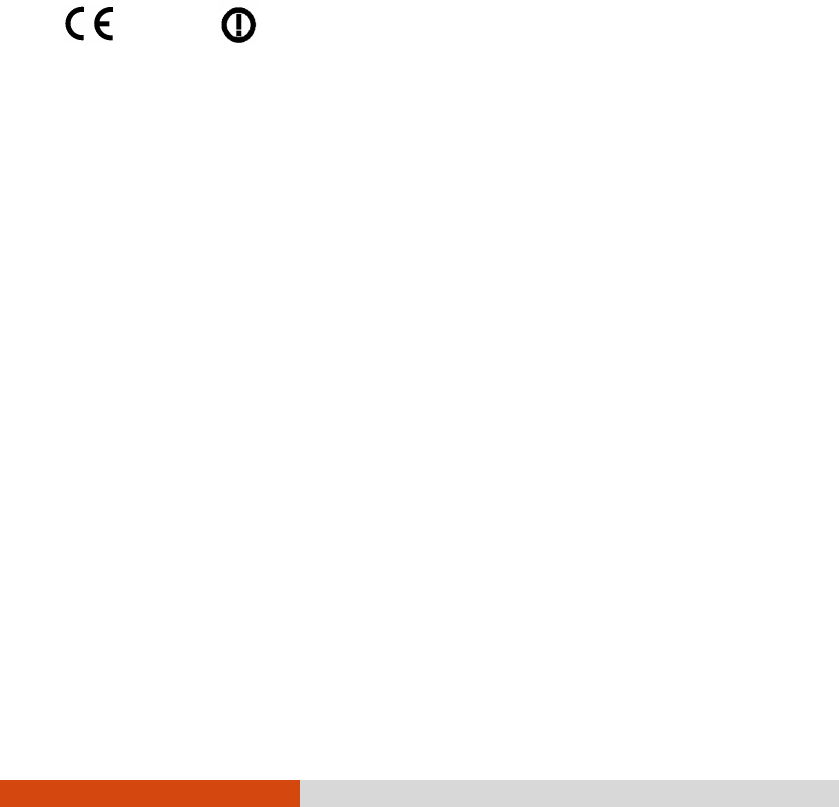
Regulatory Information B-9
EN 300 328 V1.8.1: 2012
Electromagnetic compatibility and Radio spectrum Matters (ERM); Wideband
Transmission systems; Data transmission equipment operating in the 2,4 GHz ISM
band and using spread spectrum modulation techniques; Harmonized EN covering
essential requirements under article 3.2 of the R&TTE Directive
EN 301 893 V1.7.1: 2012
Broadband Radio Access Networks (BRAN); 5 GHz high performance RLAN;
Harmonized EN covering essential requirements of article 3.2 of the R&TTE Directive
2200
Česky
Getac tímto prohlašuje, že tento E100-AVL je ve shodě se základními požadavky
a dalšími příslušnými ustanoveními směrnice 1999/5/ES.
Dansk
Undertegnede Getac erklærer herved, at følgende udstyr E100-AVL overholder de
væsentlige krav og øvrige relevante krav i direktiv 1999/5/EF.
Deutsch
Hiermit erklärt Getac, dass sich das Gerät E100-AVL in Übereinstimmung mit den
grundlegenden Anforderungen und den übrigen einschlägigen Bestimmungen der
Richtlinie 1999/5/EG befindet.
Eesti
Käesolevaga kinnitab Getac seadme E100-AVL vastavust direktiivi 1999/5/EÜ
põhinõuetele ja nimetatud direktiivist tulenevatele teistele asjakohastele sätetele.
English
Hereby, Getac, declares that this E100-AVL is in compliance with the essential
requirements and other relevant provisions of Directive 1999/5/EC.
Español
Por medio de la presente Getac declara que el E100-AVL cumple con los requisitos

B-10 Regulatory Information
esenciales y cualesquiera otras disposiciones aplicables o exigibles de la Directiva
1999/5/CE.
Ελληνική
ΜΕ ΤΗΝ ΠΑΡΟΥΣΑ Getac ΔΗΛΩΝΕΙ ΟΤΙ E100-AVL ΣΥΜΜΟΡΦΩΝΕΤΑΙ
ΠΡΟΣ ΤΙΣ ΟΥΣΙΩΔΕΙΣ ΑΠΑΙΤΗΣΕΙΣ ΚΑΙ ΤΙΣ ΛΟΙΠΕΣ ΣΧΕΤΙΚΕΣ
ΔΙΑΤΑΞΕΙΣ ΤΗΣ ΟΔΗΓΙΑΣ 1999/5/ΕΚ.
Français
Par la présente Getac déclare que l'appareil E100-AVL est conforme aux exigences
essentielles et aux autres dispositions pertinentes de la directive 1999/5/CE.
Italiano
Con la presente Getac dichiara che questo E100-AVL è conforme ai requisiti
essenziali ed alle altre disposizioni pertinenti stabilite dalla direttiva 1999/5/CE.
Latviski
Ar šo Getac deklarē, ka E100-AVL atbilst Direktīvas 1999/5/EK būtiskajām
prasībām un citiem ar to saistītajiem noteikumiem.
Lietuvių
Šiuo Getac deklaruoja, kad šis E100-AVL atitinka esminius reikalavimus ir kitas
1999/5/EB Direktyvos nuostatas.
Nederlands
Hierbij verklaart Getac dat het toestel E100-AVL in overeenstemming is met de
essentiële eisen en de andere relevante bepalingen van richtlijn 1999/5/EG.
Malti
Hawnhekk, Getac, jiddikjara li dan E100-AVL jikkonforma mal-ħtiġijiet essenzjali
u ma provvedimenti oħrajn relevanti li hemm fid-Dirrettiva 1999/5/EC.
Magyar
Alulírott, Getac nyilatkozom, hogy a E100-AVL megfelel a vonatkozó alapvetõ
követelményeknek és az 1999/5/EC irányelv egyéb elõírásainak.

Regulatory Information B-11
Polski
Niniejszym Getac oświadcza, że E100-AVL jest zgodny z zasadniczymi wymogami
oraz pozostałymi stosownymi postanowieniami Dyrektywy 1999/5/EC.
Portuguê
Getac declara que este E100-AVL está conforme com os requisitos essenciais e
outras disposições da Directiva 1999/5/CE.
Slovensko
Getac izjavlja, da je ta E100-AVL v skladu z bistvenimi zahtevami in ostalimi
relevantnimi določili direktive 1999/5/ES.
Slovensky
Getac týmto vyhlasuje, že E100-AVL spĺňa základné požiadavky a všetky príslušné
ustanovenia Smernice 1999/5/ES.
Suomi
Getac vakuuttaa täten että [type of equipment = laitteen tyyppimerkintä] tyyppinen
laite on direktiivin 1999/5/EY oleellisten vaatimusten ja sitä koskevien direktiivin
muiden ehtojen mukainen.
Svenska
Härmed intygar Getac att denna [utrustningstyp] står I överensstämmelse med de
väsentliga egenskapskrav och övriga relevanta bestämmelser som framgår av direktiv
1999/5/EG.
This device have been tested to comply with the Sound Pressure Level requirement
laid down in the applicable EN 50332-1and/or EN 50332-2 standards. Permanent
hearing loss may occur if earphones or headphones are used at high volume for
prolonged periods of time.
Logo

B-12 Regulatory Information

Regulatory Information B-13
Safety Notices
About the Battery
Caution Texts Concerning Lithium Batteries
DANISH
ADVARSEL! Lithiumbatteri – Eksplosionsfare ved fejlagtig håndtering. Udskiftning
må kun ske med batteri af samme fabrikat og type. Levér det brugte batteri tilbage
til leverandøren.
NORWEGIAN
ADVARSEL: Eksplosjonsfare ved feilaktig skifte av batteri. Benytt samme batteritype
eller en tilsvarende type anbefalt av apparatfabrikanten. Brukte batterier kasseres
i henhold til fabrikantens instruksjoner.
SWEDISH
VARNING: Explosionsfara vid felaktigt batteribyte. Använd samma batterityp eller
en ekvivalent typ som rekommenderas av apparattillverkaren. Kassera använt batteri
enligt fabrikantens instruktion.
FINNISH
VAROITUS: Paristo voi räjähtää, jos se on virheellisesti asennettu. Vaihda paristo
ainoastaan valmistajan suosittelemaan tyyppiin. Hävitä käytetty paristo valmistajan
ohjeiden mukaisesti.
ENGLISH
CAUTION: Danger of explosion if battery is incorrectly replaced. Replace only with
the same or equivalent type recommended by the equipment manufacturer. Discard
used batteries according to manufacturer's instructions.
DEUTSCH
VORSICHT: Explosionsgefahr bei unsachgemäßem Austausch der Batterie. Ersatz
nur durch denselben oder einen vom Hersteller empfohlenen gleich-wertigen Typ.
Entsorgung gebrauchter Batterien nach Angaben des Herstellers.

B-14 Regulatory Information
FRENCH
ATTENTION: II y a danger d’explosion s’il y a remplacement incorrect de la batterie.
Remplacer uniquement avec une batterie du même type ou d’un type équivalent
recommandé par le constructeur. Mettre au rebut les batteries usagées conformément
aux instructions du fabricant.
Attention (for USA Users)
The product that you have purchased contains a rechargeable battery. The battery
is recyclable. At the end of its useful life, under various state and local laws, it
may be illegal to dispose of this battery into the municipal waste stream. Check
with your local solid waste officials for details in your area for recycling options
or proper disposal.
About the AC Adapter
Use only the AC adapter supplied with your Rugged PC. Use of another type
of AC adapter will result in malfunction and/or danger.
Do not use the adapter in a high moisture environment. Never touch the adapter
when your hands or feet are wet.
Allow adequate ventilation around the adapter when using it to operate the device
or charge the battery. Do not cover the AC adapter with paper or other objects
that will reduce cooling. Do not use the AC adapter while it is inside a carrying
case.
Connect the adapter to a proper power source. The voltage requirements are
found on the product case and/or packaging.
Do not use the adapter if the cord becomes damaged.
Do not attempt to service the unit. There are no serviceable parts inside. Replace
the unit if it is damaged or exposed to excess moisture.

Regulatory Information B-15